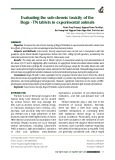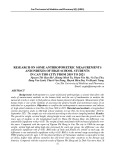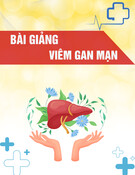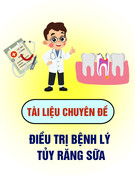
Can Tho Journal of Medicine and Pharmacy 10(7) (2024)
116
SALIVARY CHARACTERISTICS AMONG 12-YEAR-OLD CHILDREN
WITH SIGNIFICANT CARIES INDEX FROM URBAN AND
SUBURBAN SCHOOLS IN CAN THO CITY
Dang Vinh Quang*, Dang Quang Vinh, Vo Quoc Toan, Nguyen Thu Uyen,
Nguyen Huynh Thanh Thuy, Trinh Ngoc Thinh, Nguyen Thi Nhu Y,
Nguyen Pham Truc Thanh, Nguyen Ngoc Nguyet Minh
Can Tho University of Medicine and Pharmacy
*Corresponding author: quang301016@gmail.com
Received: 07/09/2023
Reviewed: 11/11/2023
Accepted: 09/01/2024
ABSTRACT
Background: Dental caries is the most prevalent chronic childhood disease with numerous
predisposing factors. Salivary properties have been linked to progressive dental caries in previous
studies. However, the role of these contributing factors in the management of dental caries in
children remains insufficient. Thus, the investigation of salivary characteristics from different types
of communities within a specific pediatric population is an obvious demand. Objectives: To assess
the salivary characteristics among school-going children aged 12 years from two urban and
suburban schools in Can Tho city. Materials and methods: A cross-sectional descriptive study was
conducted on 62 twelve-year-old students with significant caries index in two locations with different
socioeconomic status in Can Tho city. Those participants underwent saliva testing by using a saliva
testing kit (Saiva-Check BUFFER) to evaluate stimulated and unstimulated saliva parameters
including consistency, flow rate, pH and buffering capacity. Results: Out of the total population,
males and females made up 40.3% and 59.7%, respectively. Both boys and girls had similarities in
all salivary parameters (p > 0.05). Nearly half of suburban students (48.4%) had resting frothy
bubbly saliva while more than half of urban students (58.1%) had watery clear saliva at rest. All
students had moderate and normal acidic saliva before and after stimulation regardless of living
areas. The discrepancy in resting salivary viscosity, resting salivary pH was statistically significant
based on region (p < 0.05). 64.5% of the students in both suburban and urban enclaves had a normal
stimulated saliva flow rate. In contrast, a normal or high buffering capacity of stimulated saliva was
only seen in a few students. Regarding the flow rate, pH, and buffering capacity of stimulated saliva,
there were no differences between urban and suburban areas (p > 0.05). Conclusions: The findings
of this study provide additional proof of the significance of salivary properties in assessing dental
caries, especially in socioeconomic deprivation areas. Furthermore, it also implies that salivary
parameters should be taken into account as a potential indicator for managing high caries-risk
children.
Keywords: caries, children, saliva, suburban, urban
I. INTRODUCTION
Saliva plays an essential role in oral protection. The typical daily salivation volume
ranges from 0.5 to 2 liters in a healthy person. The great deal of secreted saliva is related to
multiple factors, including time duration, medication usage, the neurological system and
hydration status [1]. Salivary pH is another characteristic frequently mentioned, ranging from
6 to 7 under normal conditions [2]. Acidity in the saliva rises at night and falls in the morning.
The salivary pH parameter can also be affected by other variables, such as dietary nutrition or
systemic illness. Prior to stimulation, saliva flow is measured to be between 0.33 and 0.55 mL
per minute and can alter in response to various stimuli [1]. Saliva consistency is primarily







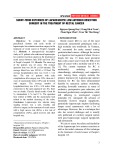
![Study on toxicities of 10β-[(2'β-hydroxy-3'- imidazol) propyl] deoxo-artemisinin (32) in reproductive and developmental progresses of mice](https://cdn.tailieu.vn/images/document/thumbnail/2025/20250228/viinuzuka/135x160/8021740737116.jpg)
